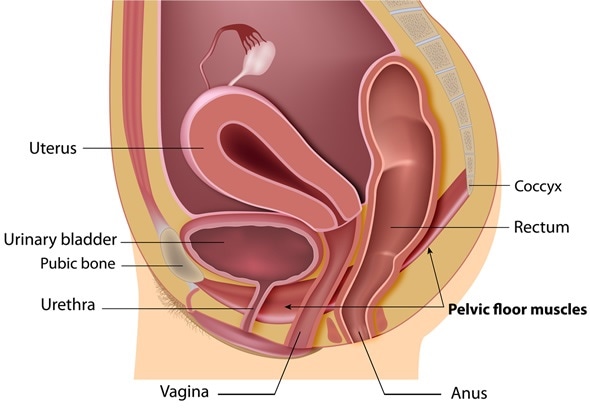Kegel exercises are special exercises that tone the pelvic floor muscles. These muscles support the pelvic organs firmly in place while allowing urine, feces and other substances to be excreted at will and in a controlled manner.

Image Credit: Alila Medical Media / Shutterstock
Weakness of these muscles causes health conditions such as laxity of the vaginal opening and urinary incontinence, as well as pelvic organ prolapse. The pelvic floor can be made and kept stronger by using Kegel exercises to keep the muscles in shape. These exercises are also called pelvic floor muscle training, and are most commonly prescribed to treat stress incontinence in women, or as preventive measures to prevent weakening of the floor after childbirth.
How to feel the pelvic floor muscles
The pelvic floor muscles control the flow of urine, as well as the escape of gas from the rectum. In order to know which ones you need to exercise, try to stop your urine while you are in the toilet. This will help you to feel the muscles being squeezed, and to learn to squeeze and relax them at will.
However, it is not good for the bladder when you repeatedly try to stop your urine flow. The detrusor muscle of the bladder contracts during urination, increasing intra-bladder pressure. Squeezing the urethra shut increases the bladder pressure and sends mixed signals to the brain. If the pressure in the bladder rises too high, the urine may flow back into the ureters.
Other ways of identifying the right muscles to squeeze have been suggested as follows:
- Inserting a finger into the vagina in the lying down position, and then squeezing as if you wanted to keep back urine. If the finger is squeezed, you are doing it right.
- Squeezing as if you wanted to keep gas from escaping
- Imagining that you are picking up a small smooth marble with only your vaginal muscles
Kegel exercises are of the greatest effectiveness only if they are done using the right muscles and with the right technique. For this reason, many healthcare providers recommend that you learn how to do these exercises under the supervision of a trained physiotherapist or other professional. Once you have become familiar with performing them correctly, you can continue to do them at home.
How to do pelvic floor muscle exercises
Lie or sit in a comfortable position and squeeze the muscles that you have identified as pelvic floor muscles to a count of 3. Now relax them and count to 3. Repeat the squeeze-relax cycle 10-15 times consecutively.
An important precaution here is to make sure you do not squeeze or tighten your abdominal, buttock, or thigh muscles at this time, as this may lead to muscle fatigue. Breathe normally while you squeeze and relax. Place your hand on your stomach, your back, your thighs, and your buttocks to make sure you are not contracting any of them by mistake. If you are, relax and try again.
Once you have got the hang of it, you can increase the time you hold the squeeze little by little till you can hold for a count of 8. You can also increase the number of sets you do at a time. Once you finish one set, rest for a few minutes before you do the next set of reps. Do them for at least 15 sets of 10 reps each, three times a day.
The best part of Kegel exercises is that nobody knows that you are doing them, so you can do them in any position – while lying down, sitting at your desk or standing up, waiting in a line or working in your home. In fact, doing these exercises in different positions strengthens them more evenly and is thus highly beneficial.
Daily workout should include these three primary positions. It is recommended that individuals try to do kegel exercises as often as possible during the first three months. Once the pelvic floor shows signs of being strong, such as the cessation of stress incontinence, the patient can continue doing these exercises but reduce the number of reps/sets slowly to a maintenance level.

Image Credit: holbox / Shutterstock
Results of pelvic floor exercises
These exercises are meant to use very small muscles, and so the effect builds up slowly over a few weeks to months. However, within a month you should be able to see some effect on the control of your urine flow.
Even if the incontinence does not disappear, it should be significantly less than before. In addition, you may find that intercourse becomes more enjoyable and climaxes are more intense, as the vagina is supported better by the toned pelvic floor muscles. These exercises improve the woman’s overall quality of life.
These exercises may also be of benefit for men who are suffering from erectile dysfunction or urinary incontinence. When the pelvic muscles are correctly used, in fact, they may discourage bladder irritability and further reduce urinary incontinence.
It is important not to stop doing the Kegel exercises when you begin to see the results, as they must be continued for a long time, preferably life-long, at a maintenance level. They can help you prevent the weakening effects of age on the pelvic musculature and stave off obvious prolapse.
Kegel exercises are safe during pregnancy, as they use no part of the body but the pelvic floor. The earlier you do them, the more insurance you have against the risk of a weak pelvic floor following childbirth.
Biofeedback in pelvic floor muscle training
These exercises are sometimes done using biofeedback to help the woman identify if she is contracting the right muscles and to motivate her to continue. Biofeedback may be obtained via electronic recorders that indicate to the patient when the right muscles are being squeezed.
Some of the different ways in which biofeedback can be used include:
- Using a vaginal or anal probe which senses pelvic muscle contractions and sends them to a monitor
- Using a skin electrode that picks up muscle contractions and sends a signal to a monitor
While the objective benefits of biofeedback in pelvic muscle training has not been demonstrated, it may offer some people a visual stimulus and motivation to continue with the exercises.
References
Further Reading